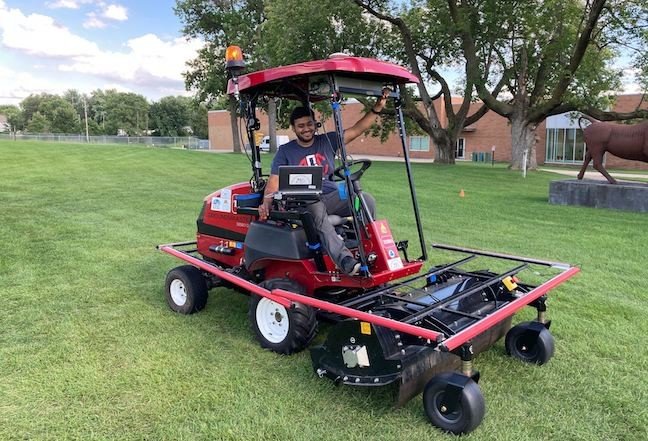Agriculture’s ‘Roomba’ is almost here

Above: CSE postdoctoral researcher Parikshit Maini sits atop the "cowbot" on the U of M St. Paul campus. Maini, along with Ph.D. candidate Minghan Wei, is leading the autonomous mower project.
Photo credit: Parikshit Maini
CS&E team develops self-driving “cowbot” to mow farm pastures
It seems autonomous vehicles are everywhere these days. Self-driving cars, vacuums that clean of their own accord, Boston Dynamics’ robot dog—all created as a means to save humans time and energy.
This idea is what motivated a CS&E team to create the “cowbot,” an autonomous lawn mower that cuts down weeds in cattle pastures.
“In terms of more relatable things, it’s like a Roomba for an agricultural farm,” said researcher Parikshit Maini. “When the cattle graze these farms, they eat the soft, grassy plants and leave behind the weeds. Once they have grazed all of the field, we want to have the mower go in and mow all of the weeds.”
Maini is a postdoctoral researcher who works in computer science and engineering professor Volkan Isler’s Robotic Sensor Networks Lab. He is helping to lead the project, along with Ph.D. student Minghan Wei.
“[Robots] can do things that are not convenient for people to do,” Wei said.
“For these mower projects, it’s not a good experience for humans to mow it manually," he said. "It’s very uncomfortable. But, we can use robots to go in and mow those weeds, and it also helps to keep the field organic instead of using chemicals to kill weeds.”
The researchers are working with vehicle manufacturer Toro, who has provided them with one of its lawn mowers to modify. They are also collaborating with the University of Minnesota Morris’ West Central Research and Outreach Center to make the machine solar-powered and self-sufficient.
The minutia of mowing
Contrary to popular belief, lawn mowing is complicated. Factor in the gopher mounds, boulders, and hills that line rural Minnesota’s cow pastures, and it can be very hard to traverse for a mower, especially a self-driving one.
“In the field, it’s actually really bumpy,” said Wei, who rode atop the cowbot during the first phase of testing. “We could not go faster than one meter per second, otherwise I would have to jump out!”
Because the terrain is so unwieldy, accuracy is key. The researchers equipped the cowbot with two types of sensors, which work together to tell the robot which direction to drive. Plus, it’s programmed with algorithms that correspond to different mowing patterns, such as u-turns and spirals. This way, the cowbot can cut weeds in whatever pattern is most efficient for the terrain it’s mowing.
The project began in 2018, with the vehicle successfully driving itself around the testing grounds at UMN Morris last summer. This year, although the COVID-19 pandemic has limited testing on campus, the team hopes to make some improvements.
“We found that when you go out in the field, there may not be weeds in every nook and corner of the pasture,” Maini explained. “But, if you do a full-coverage path, it will cover every single bit of the ground. That may not be needed.”
The researchers are planning to add a front camera that will allow the robot to detect weeds and mow more effectively. The camera would also help the cowbot map a path that uses the least amount of energy.
Rural rollercoasters and real-life cows
Maini and Wei agree that having live dairy cattle and grazing pastures on the University of Minnesota Morris campus to test the robot is a big asset.
“It kind of brings you closer to the research and actual implementation,” Maini said.
“The idea of going out in the field, having access to fields before the cattle graze on the field and initially after the cattle graze on the field, and seeing how that changes the demographics of the field—all of those things are very valuable experiences for this," he said.
Getting to work in the field also meant the pair got to have a little fun riding the autonomous mower—for research purposes, of course.
“There have been some scary moments on the mower,” Maini said with a laugh. “Sometimes there’s a drastic change in height instantaneously, and the mower nearly topples. But that’s also the fun part of it. I don’t think we would get to sit on these types of heavy machines normally.”
The researchers hope to have the cowbot finished by summer 2021. And, their lab is already looking at pursuing other agricultural technology projects involving corn fields, apple orchards, and other crops in the future.
Story by Olivia Hultgren